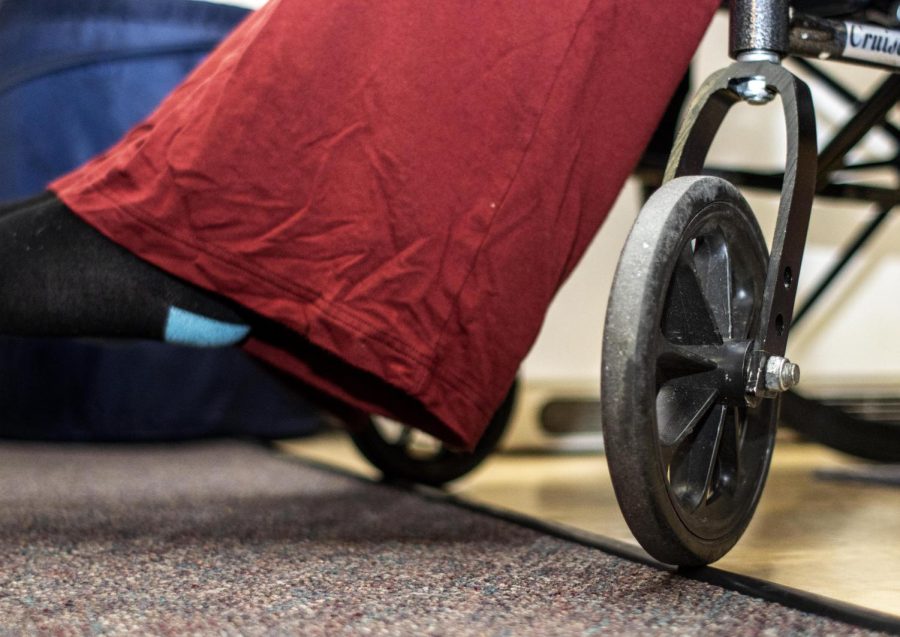History shows previous inaccessibility at Eastern
Ci Richardson, a senior psychology major, finds it difficult to navigate even in their accessible apartment. They said their apartment is accessible, but there are little things that are inconveniencing and irritating like the little bump between the kitchen and living room and the railing placement in the bathroom railings.
November 30, 2022
Moving around Eastern’s campus is challenging for students, faculty and staff with physical disabilities.
An article from 2015 by the Daily Eastern News, discusses the problems Jim Waldrip, a member of the Charleston community, faced.
Some places on Eastern’s campus, including those which are difficult for those with physical disabilities to get through. For example, Taylor Hall has an elevator on its North side, but not the South side.
This makes it difficult for everyone to be able to get to their floors, even those without disabilities. When students move in and out of their rooms, they have to carry heavy objects up and down several flights of stairs. This could be a safety hazard as well.
“If you are a business that operates with 3 floors or more, you are required to have a public elevator, which is also required to be ADA accessible,” according to adacentral.com.
Waldrip also talked about how they do not have enough time to get in the elevator because the doors close too quickly.
Ci Richardson, a senior psychology major, talked about some of the flaws they had with Eastern’s campus, and what could be done to make the campus more accessible.
“Everyone can agree that the sidewalks are awful,” Richardson said. “Not every building has a push to open button… There’s still places where I can’t through some of the doors and I have the standard size wheelchair.”
Richardson has been working with Eastern administration to correct accessibility issues on campus after The News covered issues Richardson faces back in June.
Improvements have been made to the campus since then.
Currently there are 4,997 on-campus students and 340 of them are documented through the Office of Student Disability Services.
According to the CDC, 13.7% of the 61 million people in the United States with disabilities are mobility related. Statistically, around 41 students at Eastern would have mobility related disabilities on campus based on the United States population.
However, only four students at Eastern are registered with Eastern’s Student Disability Services with mobility disabilities.
Students have complained about some of the problems they have faced, such as being hit in the face with a door and being stuck in elevators in Coleman and Buzzard Hall.
When searching for answers as to what Eastern does to help improve their accessibility, Director of Disability Services April Jackson refused to comment on the process for accommodations for students at Eastern.
According to Laura McLaughlin, Eastern’s general counsel, Jackson is the ADA coordinator for students and Linda Holloway, director of human resources, is the ADA coordinator for employees.
In an article in The News from 2015, then director of student disability services, Kathy Waggoner, explained the process for accommodations at Eastern.
Eastern students first meet with a staff member from the office to assess what accommodations are needed on an individual basis with accommodations only changed upon the student’s request. Waggoner reported the office works with the Facilities Planning and Management, the Gregg Technology Center, Housing and Dining Services and the on-campus ADA coordinator for students.
Keith Hays, ADA IT coordinator at University of Illinois Urbana-Champaign, provided information on how some things are handled on their campus.
Hays said that the school is trying to meet federal funds for building construction and classroom requirements. They also have an accommodation program for students who require the accommodation.
Some of the examples that Hays said were issues with the testing times or conversions of medias for the individual.
For these accommodations, students would go to the office of Disability Resources and Educational Services, DRES. They also offer to provide a wheelchair servicing operation.
The Office for Access and Equity, OAE, also offers services for anything non-classroom related for employees, applicants and visitors.
Hays broke down how the accommodation process works.
“An individual will contact OAE or DRES, they will give some biographical information,” Hays said. “They will, because of the way the ADA accommodations act works, they’ll need to supply medical documentation in these circumstances to show that they do indeed qualify for what’s known as a reasonable accommodation, under the law. Once that is confirmed, then the access specialist will work with them to determine what is needed for their accommodations, so it’s on an individualized basis.”
Hays also said that the student will get a letter stating their accommodations, which they can give to their professor so they can work with them to facilitate the accommodation.
“It’s not the employees’ responsibility to make sure it happens, it is the units and for students that they give the letter of accommodation, but it’s not the students responsibility to ensure that the accommodation is implemented,” Hays said. “That is the faculty members responsibility, their instructors.”
If there is an issue with the accommodation, the student can return to the access specialist and report the issue, or the student has the option to fill out a grievance form, which expresses that the student is having trouble arranging the accommodation.
One large issue that the UIUC is dealing with is legacy buildings. They are historical buildings which were made before the ADA was created. Some of the departments that members there want to put are not able to be accessed. They are running out of space on the campus and have to “cram” departments into buildings, according to Hays.
Cam’ron Hardy can be reached at 581-2812 or at [email protected].




















































